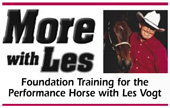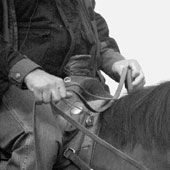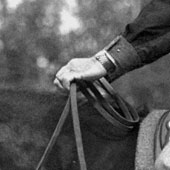 Responsive Hands Create a Responsive Mouth
Responsive Hands Create a Responsive Mouth
Have you ever ridden a horse that was so responsive to the reins, it could have been made from silk threads and never broken? If you follow the basic strategies I’m going to lay out, you should be able to create that level of responsiveness in your horse with time and practice.
So where do you start? With yourself! Until you’re trained, how do you think you could train a horse?
Here are the first two secrets:
1. Make your horse think he’s a hero. Learn to really look for positive gestures from your horse, and make sure he knows when he’s “done good!”
2. Learn to make your corrections effective.
Always start your cues as if you were riding with those silk reins. If the horse doesn’t respond to light pressure then start moving your hands until you get a response.

Here, I’m just making contact with the bit. To release pressure, I can relax my fingers and move my hands forward.
If you’re asking for vertical flexion, that is for your horse to round his spine toward your direct rein (with his ears staying relatively level), and you feel any resistance, gently start to work the rein by moving just your fingers. Never take the rein up quickly, but always do it smoothly so that nothing causes any pain or fear in your horse. You want to keep him relaxed.
If you’re asking for lateral flexion, that is for the horse to round his neck and drop his chin, and you feel some resistance—work your hands, and the bit, back and forth in his mouth to break the resistance.
Critical Components
1. Always start softly and work your way up if the resistance continues.
2. As soon as your horse starts to give to your hands, just a gesture—release the pressure, giving him lots of slack.

Hands in the box. This is the area that I consider my neutral zone. Slack in the rein and hands right above the horse’s neck.
If he doesn’t do what you want right away, you create a situation that is not comfortable, yet not painful. You want him wish that you would stop that, yet not panic about it.
The first time or two, he’s likely to do the right thing by mistake, just sort of stumble into it, and that’s all the more reason why you need to be extra fast with your release. What better thing than to have your horse figure out that something in his power will make you happy. He’ll start searching for that thing, and what could be better than that!
Lastly: Keep Life in Your Hands
What I mean by this is that you never want to just hold on to the bit with steady “dead” pressure.
1. If you pick up the reins and you get what you want—release.
2. If you pick up the reins and you don’t get what you want, start working your reins in one way or another to get the response you want.
Editor’s Note: More with Les is a regular California Horsetrader column. Les Vogt has won more than 15 World Championships, including two wins at the NRCHA Snaffle Bit Futurity. Although Les still rides and occasionally shows, his focus is giving clinics around the world and developing products for the performance horseman. To learn more about Les and to see his clinic schedule, visit the Web site:
Leave a Comment
All fields must be filled in to leave a message.